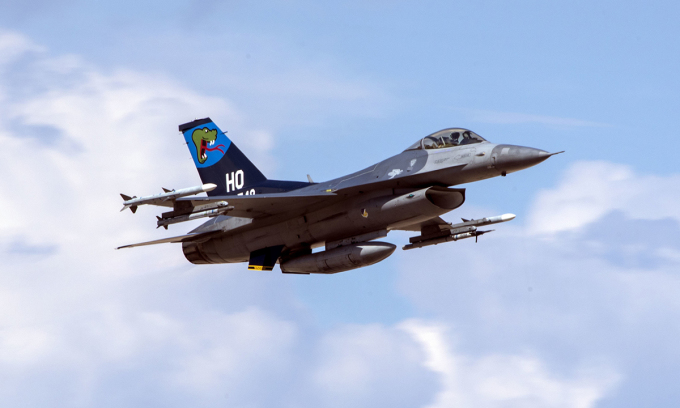
A U.S. Air Force F-16 that crashed in New Mexico last year went down due to a failure in the fifth-stage compressor, a component often referred to as the “blind spot inside the engine”, according to an official investigation report.
The Incident: Sudden Failure Just Seconds After Takeoff
On April 30, 2024, a formation of four F-16 fighters took off from Holloman Air Force Base in New Mexico for a routine training flight. The weather was clear, with good visibility and light winds.
Each jet took off 15 seconds apart, but 33 seconds after liftoff, the pilot of the third aircraft in the sequence reported hearing a loud explosion, followed by a sudden loss of thrust and violent airframe shaking at an altitude of just over 300 meters.
The pilot immediately initiated emergency procedures, trying to diagnose the issue while maintaining altitude. However, as the jet descended below 500 meters, the pilot determined there was no chance to restart the engine and prepared for ejection.
“Three is ejecting,” the pilot radioed, just 105 seconds after taking off from Holloman.
Four seconds later, the ejection seat fired at a speed of approximately 290 km/h. Due to the low altitude, the seat’s automatic parachute deployment system activated immediately upon exit. The pilot landed safely and was uninjured.
The remaining three F-16s circled overhead, guiding search-and-rescue teams to the crash site. A nearby U.S. Army helicopter arrived within five minutes and transported the pilot back to the base after a medical check-up.
Investigation: The ‘Blind Spot’ Inside the F-16 Engine
A U.S. Air Force accident investigation board concluded that the crash was caused by a catastrophic failure in the fifth-stage compressor of the F100-PW-220 jet engine.
During the flight, a compressor blade in the fifth stage snapped off, ripped through the engine at high speed, and triggered an internal explosion.
"The engine suffered critical failure at low altitude, leaving no chance for the aircraft to return to base," investigators stated.
The F100-PW-220, built by Pratt & Whitney, is a twin-spool turbofan engine with 13 compressor stages that progressively compress and heat air to generate thrust.
Routine maintenance checks on the engine are conducted every 100 flight hours. Mechanics can inspect the first four compressor stages through the air intake and the sixth through thirteenth stages from the rear exhaust section using specialized cameras.
However, the fifth-stage compressor sits in a unique location, not visible from either end of the engine, making it the only component never directly inspected during regular maintenance.
“This part of the engine is essentially a ‘blind spot,’ only accessible when the entire engine is dismantled during a full depot-level overhaul at Tinker Air Force Base,” the report noted.
The F100 engine in the crashed F-16 was last overhauled in 2016. Investigators did not rule out the possibility that the compressor blades were incorrectly installed at that time, which could have weakened them over time.
However, engine mechanics insisted that if the compressor had been improperly assembled, it would have failed during post-maintenance testing before being returned to service.
As a result, the exact cause of the blade failure remains unknown.
“All personnel involved, including the pilot, maintenance crews, and flight supervisors at Holloman Air Force Base, were found to have followed proper procedures,” the Air Force stated.
“The failure was undetectable during routine inspections, and even during the last full engine overhaul nearly a decade ago, there was no way to predict this specific failure.”
F-16: A Backbone of U.S. and Allied Air Forces
The F-16 Fighting Falcon, developed by General Dynamics in the 1970s, is a multi-role combat jet used by the U.S. and dozens of allied nations.
Each F-16 costs between $30–35 million, but the price varies based on version, contract terms, and political agreements.
The jet has a maximum speed of 2,120 km/h at 12 km altitude, with a combat radius of 546 km when fully loaded with weapons.
The crash in New Mexico is now prompting the U.S. Air Force to re-evaluate maintenance procedures, particularly regarding mid-stage compressor inspections.
(Sources: Task & Purpose, AFP, AP)
Hello Shuttle will strive to bring the latest updates. At the end of the day.
Are you looking for reliable airport and cruise port transfer services in Los Angeles?
We offer professional, safe, and punctual transportation from
Los Angeles Airport - LAX
Long Beach Airport - LGB
John Wayne Airport - SNA
San Pedro cruise port
Long Beach cruise port
Disneyland
and other destinations.
Let us make your journey stress-free and comfortable with our dedicated drivers and high-quality vehicles. Book now for the perfect travel experience at www.helloshuttle.com or call 944-800-5678!


